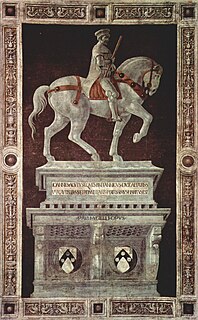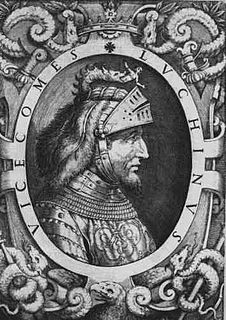Related Research Articles

Gil Álvarez Carrillo de Albornoz more commonly Gil de Albornoz, was a Spanish cardinal, archbishop, Chancellor of Toledo and ecclesiastical leader. He was a descendant of the kings of León and Aragón and founder of the Collegio di Spagna, an academic institution of Bologna.

Condottieri were Italian captains in command of mercenary companies during the Middle Ages and multinational armies during the early modern period. They notably served European monarchs and Popes during the Italian Wars of the Renaissance and the European Wars of Religion. Notable condottieri include Prospero Colonna, Giovanni dalle Bande Nere, Cesare Borgia, the Marquis of Pescara, Andrea Doria, and the Duke of Parma.

Sir John Hawkwood was an English soldier who served as a mercenary leader or condottiero in Italy. As his name was difficult to pronounce for non-English-speaking contemporaries, there are many variations of it in the historical record. He often referred to himself as "Haukevvod" and in Italy he was known as "Giovanni Acuto", meaning literally "John Sharp" referring to his "cleverness or cunning". His name was Latinised as Johannes Acutus. Other recorded forms are "Aucgunctur", "Haughd", "Hauvod", "Hankelvode", "Augudh", Auchevud", "Haukevvod", "Haukwode" and "Haucod". His exploits made him a man shrouded in myth in both England and Italy. Much of his enduring fame results from the surviving large and prominent fresco portrait of him in the Duomo, Florence, made in 1436 by Paolo Uccello, seen every year by 4 1/2 million tourists.

Braccio da Montone, born Andrea Fortebraccio, was an Italian condottiero.

Bernabò or Barnabò Visconti was an Italian soldier and statesman who was Lord of Milan.
Werner von Urslingen was a mercenary of German-speaking origins in the Holy Roman Empire. He is also known as Werner of Urslingen.

Alberico da Barbiano was the first of the Italian condottieri. His master in military matters was the English mercenary John Hawkwood, known in Italy as Giovanni Acuto. Alberico's compagnia fought under the banner of Saint George, as the compagnia San Giorgio.

The Wars in Lombardy were a series of conflicts between the Republic of Venice and the Duchy of Milan and their respective allies, fought in four campaigns in a struggle for hegemony in Northern Italy that ravaged the economy of Lombardy and weakened the power of Venice. They lasted from 1423 until the signing of the Treaty of Lodi in 1454. During their course, the political structure of Italy was transformed: out of a competitive congeries of communes and city-states emerged the five major Italian territorial powers that would make up the map of Italy for the remainder of the 15th century and the beginning of the Italian Wars at the turn of the 16th century. They were Venice, Milan, Florence, the Papal States and Naples. Important cultural centers of Tuscany and Northern Italy—Siena, Pisa, Urbino, Mantua, Ferrara—became politically marginalized.
Astorre Manfredi was an Italian condottiero. He was the son of Giovanni Manfredi, who had been lord of Faenza and other castles in the area before the Papal reconquest. Astorre lived for a while in Pistoia after his father had lost his last possession in Romagna; three years after the latter's death, in 1375, he managed to recover Granarolo.

The Battle of Parabiago was fought in February 1339 near Parabiago, in Lombardy, northern Italy, between the Milanese army and the St. George's Mercenaries of Lodrisio Visconti. A renowned condottiero, the latter was an exiled member of the Visconti family then in power in Milan with a kind of triumvirate formed by Azzone and his uncles, Luchino and Archbishop Giovanni Visconti. Aiming to return victoriously to his city, he hired some 2,500 knights, mainly from Germany, and 1,000 Swiss infantry which had fought in the unsuccessful war of Mastino II della Scala for the hegemony in northern Italy. These units were led by Werner von Urslingen and Konrad von Landau.
Lodrisio Visconti was an Italian condottiero.
The Great Company was a group of mercenaries, chiefly of German origin but operating in the Italian peninsula, who flourished in the mid-14th century. At its height, the company numbered approximately 10,000-12,000 men, chiefly armored cavalry. The Great Company's power set the pattern for later condottieri who came to dominate Renaissance Italian warfare.

A free company was an army of mercenaries between the 12th and 14th centuries recruited by private employers during wars. They acted independently of any government, and were thus "free". They regularly made a living by plunder when they were not employed; in France they were the routiers and écorcheurs who operated outside the highly structured law of arms. The term "free company" is most applied to those companies of soldiers which formed after the Peace of Brétigny during the Hundred Years' War and were active mainly in France, but it has been applied to other companies, such as the Catalan Company and companies that operated elsewhere, such as in Italy and the Holy Roman Empire.
The Compagnia di San Giorgio was the name of several companies of mercenaries in Italy during the 14th century.

Ascanio della Corgna was an Italian condottiere from Umbria. He rose to become Marchese di Castiglione del Lago, in part due to his family connections to a Pope.
Konrad Wirtinger von Landau, known in Italy as Conte Lando, was a German military adventurer and condottiero who was active in north and central Italy.
Albert Sterz was a German noble who was a leader of mercenary Free companies, primarily operating in Italy.
The Company of the Rose was a company of mercenary soldiers which operated in northern Italy in the 14th and 15th centuries.
Giovanni da Barbiano was an Italian condottiero, the leader of a force of mercenary soldiers. He was a brother or nephew of the condottiero Alberico da Barbiano.

Ruggero Cane Ranieri was an Italian military leader and a major political figure in the city of Perugia during the first half of the 15th century. He was a member of the noble lineage of the Counts Ranieri of Civitella Ranieri, near Umbertide.
References
- ↑ Villalon, Andrew. The Hundred Years War: A Wider Focus, Part 1. p. 204.
- Based on a translation of the equivalent article on Italian Wikipedia